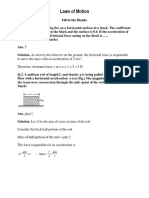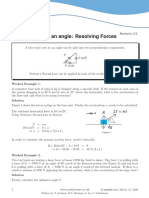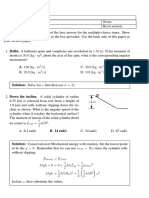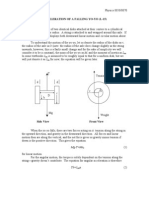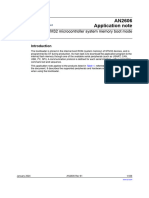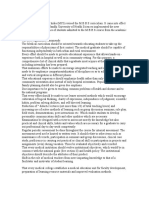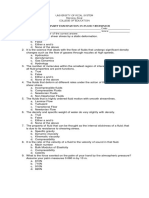MC Web Mech2 9 2009 PDF
MC Web Mech2 9 2009 PDF
Uploaded by
AshleyJaneFuentesCopyright:
Available Formats
MC Web Mech2 9 2009 PDF
MC Web Mech2 9 2009 PDF
Uploaded by
AshleyJaneFuentesOriginal Title
Copyright
Available Formats
Share this document
Did you find this document useful?
Is this content inappropriate?
Copyright:
Available Formats
MC Web Mech2 9 2009 PDF
MC Web Mech2 9 2009 PDF
Uploaded by
AshleyJaneFuentesCopyright:
Available Formats
Mechanics 2.9.
Forces acting at an angle (with Friction)
mc-web-mech2-9-2009
Here as in leaflet 2.6, we consider forces that act at an angle, but this time including friction.
Worked Example 1.
A force of 18 N acts on a particle, of mass 7.5 kg, at an angle of 30◦ above the horizontal. The
particle is on a rough horizontal plane. Given that the particle is on the point of slipping, what is
the coefficient of friction, between the particle and the plane?
Solution R
Figure 1 shows the forces acting on the parti-
18 N
cle. o
F 30
Resolving vertically: R = 7.5g − 18sin 30◦
Resolving horizontally: F = 18 cos 30◦
As the particle is on the point of slipping, fric- mg
tion is limiting (F = FM AX ), so F = µR: Figure 1
18 cos 30◦ = µ(7.5g − 18 sin 30◦ )
18 cos 30◦
µ = = 0.24
7.5g − 18 sin 30◦
Worked Example 2.
A particle, of mass m kg, is in equilibrium under a force of magnitude T N, which acts at an angle α
above the horizontal. Given the coefficient of friction between the particle and the rough horizontal
µmg
plane is µ, show that T ≤
cos α + µ sin α
Solution R
Resolving vertically:
T
F α
R + T sin α − mg = 0 ⇒ R = mg − T sin α
Resolving horizontally:
mg
T cos α − F = 0 ⇒ F = T cos α Figure 2
As the particle is in Equilibrium: F ≤ µR
T cos α ≤ µ(mg − T sin α)
T cos α ≤ µmg − µT sin α
T cos α + µT sin α ≤ µmg
T (cos α + µ sin α) ≤ µmg
µmg
T ≤
cos α + µ sin α
www.mathcentre.ac.uk 1 c mathcentre 2009
Written by T. Graham, M.C. Harrison, S. Lee, C.L.Robinson
Worked Example 3.
A light inextensible rope is used to pull a particle of mass 2.5 kg along a rough horizontal plane. If
the tension in the rope is 25 N and acts at an angle of 25◦ above the horizontal and the coefficient of
sliding friction between the particle and the surface is 0.55, what is the acceleration of the particle?
Solution R
As the motion is horizontal, the sum of vertical 25 N
components of the force equals zero.
o
Resolving vertically: R = 2.5g − 25 sin 25◦ F 25
As the particle is moving the frictional force
satisfies F = µR, where µ is the coefficient of
sliding friction:
mg
F = µR = 0.55(2.5g − 25 sin 25◦ )
Figure 3
The resultant force is 25cos 25◦ − F .
Use Newton’s Second Law parallel to the
plane:
ma = 25 cos 25◦ − 0.55(2.5g − 25 sin 25◦ )
25 cos 25◦ − 0.55(2.5g − 25 sin 25◦ )
a = = 6.0 m s−2 (2 s.f.)
2.5
Exercises
1. A force of 16 N acts on a particle, of mass 11 kg, at an angle of 18◦ above the horizontal.
The particle is on a rough horizontal plane. Given the particle is on the point of slipping, what
is the coefficient of friction, between the particle and the plane?
2. A particle, of mass 6 kg, is in equilibrium on a rough horizontal plane under a force of magnitude
T N, which acts at an angle 15◦ above the horizontal. Given the coefficient of friction between
the particle and the rough horizontal plane is 0.35, what values could T take?
3. A light inextensible rope is used to pull a particle of mass 3 kg along a rough horizontal
plane. The tension in the rope is 15 N and acts at an angle of 40◦ above the horizontal.
If the coefficient of sliding friction between the particle and the surface is 0.45, what is the
acceleration of the particle?
4. A force of 48 N acts on a particle on a rough horizontal plane at an angle of 20◦ above the
horizontal. Given the particle is on the point of slipping, and the coefficient of friction between
the particle and the plane is 0.6, what is the mass of the particle?
5. The coefficient of friction between a particle, of mass 8.5 kg, and a rough horizontal plane is
0.8. Given a force of 50 N acts on the particle at an angle of 40◦ above the horizontal, does
slipping occur?
6. A light inextensible rope is used to pull a particle of mass 2 kg along a rough horizontal plane.
Given the tension in the rope is 27 N and acts at an angle of 30◦ above the horizontal and
that the particle is moving with an acceleration of 10 m s −2 , what is the coefficient of sliding
friction between the particle and the surface?
Answers (all to 2 s.f.)
1. 0.15 2. T ≤ 19 N 3. 0.86 m s −2
4. 9.3 kg 5. No, F = 38 N< 41 N (FM AX ) 6. 0.55
www.mathcentre.ac.uk 2 c mathcentre 2009
Written by T. Graham, M.C. Harrison, S. Lee, C.L.Robinson
You might also like
- Sheet Solutions Newton Laws of Motion V2.1No ratings yetSheet Solutions Newton Laws of Motion V2.117 pages
- Revision Exercise 3: Concept Traps (p.137)No ratings yetRevision Exercise 3: Concept Traps (p.137)8 pages
- Rotational Dynamics-03-Subjective SolvedNo ratings yetRotational Dynamics-03-Subjective Solved16 pages
- MathCentre - Forces Acting at An Angle (Resolving Forces)No ratings yetMathCentre - Forces Acting at An Angle (Resolving Forces)2 pages
- Introduction To Physics Practice Sheet 03 Only PDF NSEP Batch 2024No ratings yetIntroduction To Physics Practice Sheet 03 Only PDF NSEP Batch 20245 pages
- Physics Worksheet Solutions Reaction Force INo ratings yetPhysics Worksheet Solutions Reaction Force I1 page
- Pradeep Chemistry Book For Class Xi Pdf-IitiansNo ratings yetPradeep Chemistry Book For Class Xi Pdf-Iitians6 pages
- 010 Lect 9 Unit 2 Application of Newtons LawsNo ratings yet010 Lect 9 Unit 2 Application of Newtons Laws20 pages
- Medina Sarah Helping Around The World Read and Discover Leve PDFNo ratings yetMedina Sarah Helping Around The World Read and Discover Leve PDF1 page
- Chapter 5 Revolutionizing Human Life - GROUP 3 - BSN 2ANo ratings yetChapter 5 Revolutionizing Human Life - GROUP 3 - BSN 2A5 pages
- Peruzzo Manuale Istruzione Art 710 09 11 2018No ratings yetPeruzzo Manuale Istruzione Art 710 09 11 201832 pages
- Stok Opname Apotek Puskesmas Guali November 2022: No. Nama Obat Jumlah Exp. Date No. Batch TabletNo ratings yetStok Opname Apotek Puskesmas Guali November 2022: No. Nama Obat Jumlah Exp. Date No. Batch Tablet6 pages
- Bed Revised Date Sheet of B. Tech. 1st Semester 2010-11No ratings yetBed Revised Date Sheet of B. Tech. 1st Semester 2010-112 pages
- Notice: National Register of Historic Places Notification of Pending Nominations and Related ActionsNo ratings yetNotice: National Register of Historic Places Notification of Pending Nominations and Related Actions1 page
- The Mandelbrot Set and Its Associated Julia SetsNo ratings yetThe Mandelbrot Set and Its Associated Julia Sets18 pages
- Consumer Brochure All Page Updated On 13th JulyNo ratings yetConsumer Brochure All Page Updated On 13th July47 pages
- RS485 Board (3.3V/5V) User Manual: 1. DescriptionNo ratings yetRS485 Board (3.3V/5V) User Manual: 1. Description5 pages
- An2606 Stm32 Microcontroller System Memory Boot Mode StmicroelectronicsNo ratings yetAn2606 Stm32 Microcontroller System Memory Boot Mode Stmicroelectronics436 pages
- A Brewers Guide To Opening A Nano Brewery - Your 10,000 Brewery Consultant For 15 (Dan Woodske)No ratings yetA Brewers Guide To Opening A Nano Brewery - Your 10,000 Brewery Consultant For 15 (Dan Woodske)54 pages
- Nondestructive Testing White Paper - v12No ratings yetNondestructive Testing White Paper - v1224 pages
- Confined Flow Around An Impermeable WallNo ratings yetConfined Flow Around An Impermeable Wall0 pages
- Manual de Operacion Infranor SMT 100 - 05No ratings yetManual de Operacion Infranor SMT 100 - 0532 pages




